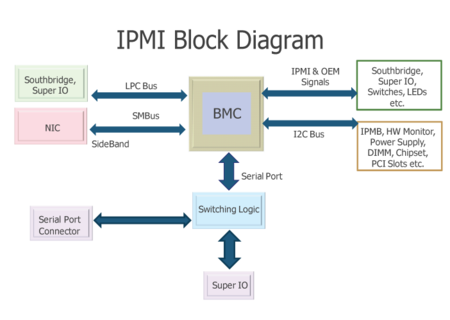
In computing, the Preboot eXecution Environment, PXE specification describes a standardized client–server environment that boots a software assembly, retrieved from a network, on PXE-enabled clients. On the client side it requires only a PXE-capable network interface controller (NIC), and uses a small set of industry-standard network protocols such as DHCP and TFTP.

A terminal server connects devices with a serial port to a local area network (LAN). Products marketed as terminal servers can be very simple devices that do not offer any security functionality, such as data encryption and user authentication. The primary application scenario is to enable serial devices to access network server applications, or vice versa, where security of the data on the LAN is not generally an issue. There are also many terminal servers on the market that have highly advanced security functionality to ensure that only qualified personnel can access various servers and that any data that is transmitted across the LAN, or over the Internet, is encrypted. Usually, companies that need a terminal server with these advanced functions want to remotely control, monitor, diagnose and troubleshoot equipment over a telecommunications network.
Advanced Telecommunications Computing Architecture is the largest specification effort in the history of the PCI Industrial Computer Manufacturers Group (PICMG), with more than 100 companies participating. Known as AdvancedTCA, the official specification designation PICMG 3.x was ratified by the PICMG organization in December 2002. AdvancedTCA is targeted primarily to requirements for "carrier grade" communications equipment, but has recently expanded its reach into more ruggedized applications geared toward the military/aerospace industries as well. This series of specifications incorporates the latest trends in high speed interconnect technologies, next-generation processors, and improved Reliability, Availability and Serviceability (RAS).
The Dell Remote Access Controller (DRAC) is an out-of-band management platform on certain Dell servers. The platform may be provided on a separate expansion card, or integrated into the main board; when integrated, the platform is referred to as iDRAC.
Integrated Lights-Out, or iLO, is a proprietary embedded server management technology by Hewlett-Packard Enterprise which provides out-of-band management facilities. The physical connection is an Ethernet port that can be found on most ProLiant servers and microservers of the 300 and above series.
Open Platform Management Architecture (OPMA) is an open, royalty free standard for connecting a modular, platform hardware management subsystem to a computer motherboard. Platform hardware management generally refers to the remote monitoring of platform hardware variables such as fan speed, voltages, CPU and enclosure temperatures along with a wide range of other sensors. It also implies the ability to remotely control the power state of the platform and to reset the system back into an operational state should it "hang". A significant advantage of OPMA over previous generation management subsystem attachment methods is that OPMA does not consume a PCI socket. OPMA cards are also smaller and lower cost than their PCI predecessors.

Intel vPro technology is an umbrella marketing term used by Intel for a large collection of computer hardware technologies, including VT-x, VT-d, Trusted Execution Technology (TXT), and Intel Active Management Technology (AMT). When the vPro brand was launched, it was identified primarily with AMT, thus some journalists still consider AMT to be the essence of vPro.

In systems management, out-of-band management is a process for accessing and managing devices and infrastructure at remote locations through a separate management plane from the production network. OOB allows a system administrator to monitor and manage servers and other network-attached equipment by remote control regardless of whether the machine is powered on or whether an OS is installed or functional. It is contrasted to in-band management which requires the managed systems to be powered on and available over their operating system's networking facilities.
The IBM Remote Supervisor Adapter is a full-length ISA or PCI adapter produced by the IBM corporation.

Intel Active Management Technology (AMT) is hardware and firmware for remote out-of-band management of select business computers, running on the Intel Management Engine, a microprocessor subsystem not exposed to the user, intended for monitoring, maintenance, updating, and repairing systems. Out-of-band (OOB) or hardware-based management is different from software-based management and software management agents.
Host Embedded Controller Interface (HECI) is technology introduced in 2006 used for Active Management Technology (AMT) in Intel chipsets that support Core 2 Duo microprocessors.
The Hardware Platform Interface (HPI) is an open specification that defines an application programming interface (API) for platform management of computer systems. The API supports tasks including reading temperature or voltage sensors built into a processor, configuring hardware registers, accessing system inventory information like model numbers and serial numbers, and performing more complex activities, such as upgrading system firmware or diagnosing system failures.
Intel Active Management Technology (AMT) is hardware-based technology built into PCs with Intel vPro technology. AMT is designed to help sys-admins remotely manage and secure PCs out-of-band when PC power is off, the operating system (OS) is unavailable, software management agents are missing, or hardware has failed.
Alert Standard Format (ASF) is a DMTF standard for remote monitoring, management and control of computer systems in both OS-present and OS-absent environments. These technologies are primarily focused on minimizing on-site I/T maintenance, maximizing system availability and performance to the local user.
Desktop and mobile Architecture for System Hardware (DASH) is a Distributed Management Task Force (DMTF) standard.
The MegaRAC from American Megatrends is a product line of baseboard management controller (BMC) firmware packages and formerly Service Processors providing complete Out-of-band, or Lights-out remote management of computer systems independently of the Operating System status or location to troubleshoot computers and assure continuity of service. MegaRAC Service Processors came in various formats - PCI cards, embedded modules and software-only.
Management Component Transport Protocol (MCTP) is a protocol designed by the Distributed Management Task Force (DMTF) to support communications between different intelligent hardware components that make up a platform management subsystem, providing monitoring and control functions inside a managed computer system. This protocol is independent of the underlying physical bus properties, as well as the data link layer messaging used on the bus. The MCTP communication model includes a message format, transport description, message exchange patterns, and operational endpoint characteristics.

The Intel Management Engine (ME), also known as the Intel Manageability Engine, is an autonomous subsystem that has been incorporated in virtually all of Intel's processor chipsets since 2008. It is located in the Platform Controller Hub of modern Intel motherboards.
The Redfish standard is a suite of specifications that deliver an industry standard protocol providing a RESTful interface for the management of servers, storage, networking, and converged infrastructure.
WinRM (Windows Remote Management) is Microsoft's implementation of WS-Management in Windows which allows systems to access or exchange management information across a common network. Utilizing scripting objects or the built-in command-line tool, WinRM can be used with any remote computers that may have baseboard management controllers (BMCs) to acquire data. On Windows-based computers including WinRM, certain data supplied by Windows Management Instrumentation (WMI) can also be obtained.







